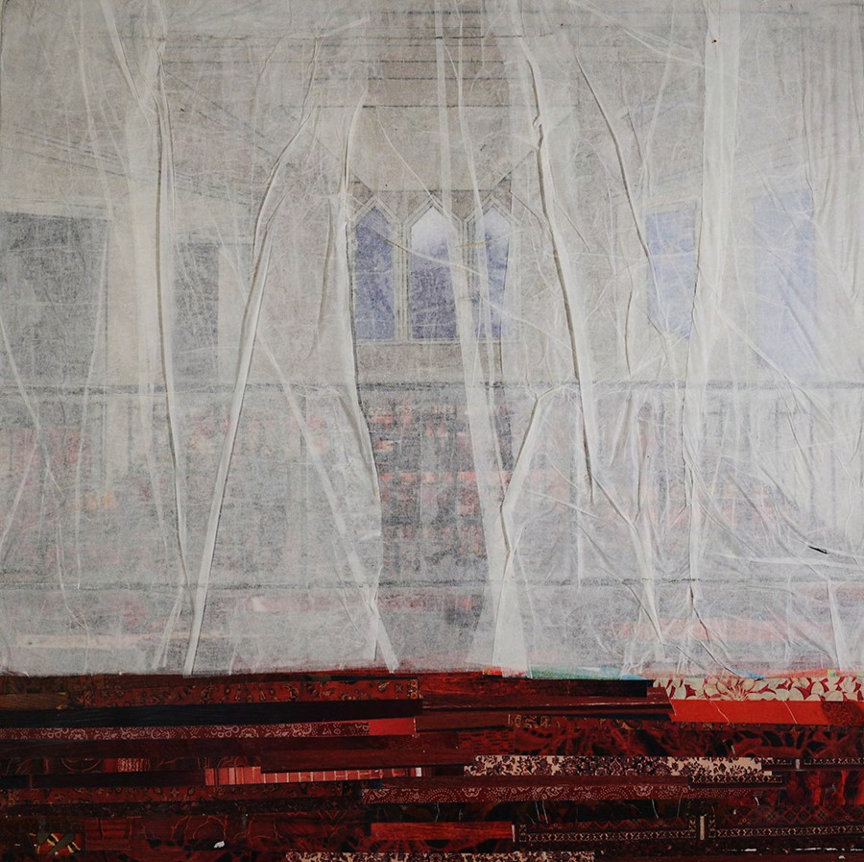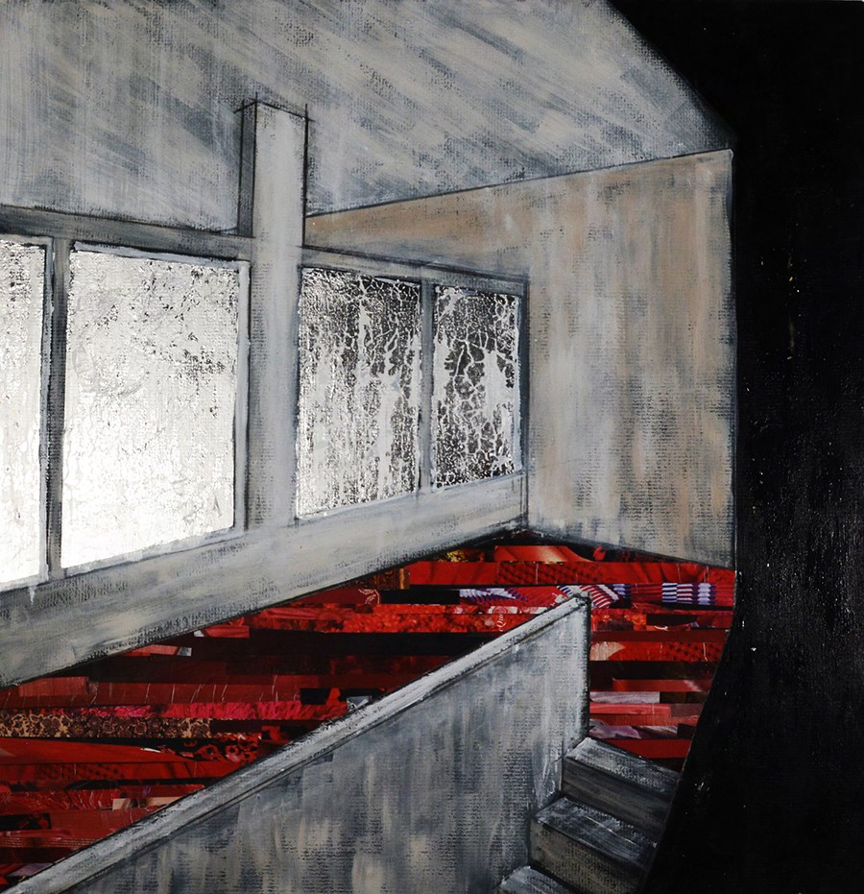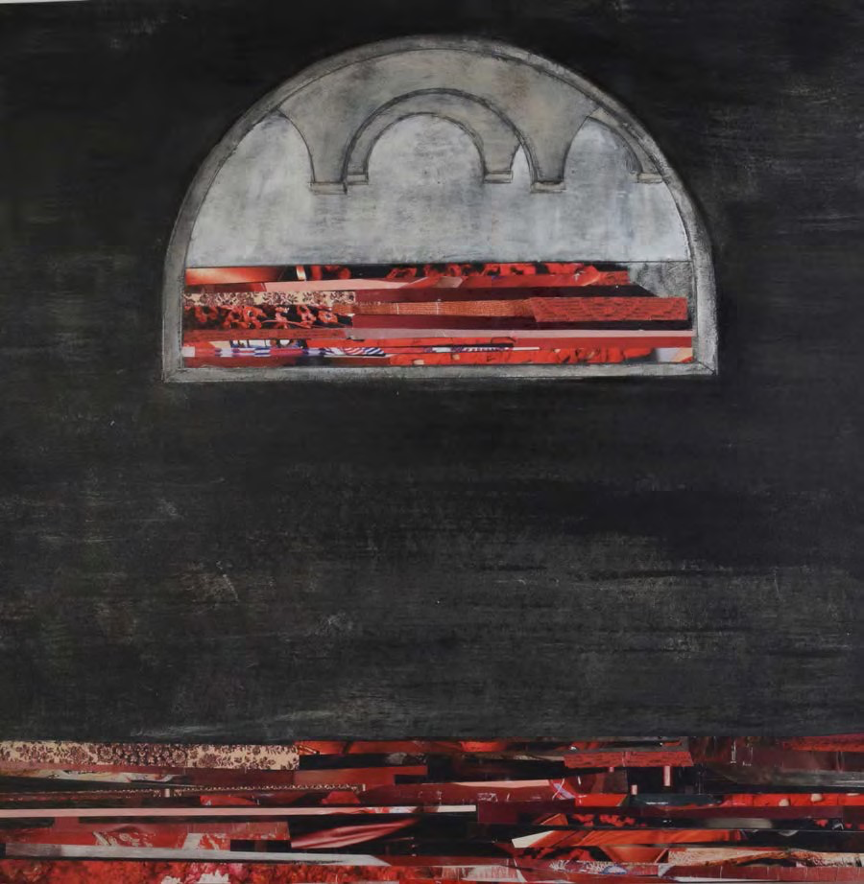Tammy Gaber, PhD
Laurentian University, Sudbury, Ontario tgaber@laurentian.ca
Collage
The production of something that is unintentionally both haunting and surprising may be the very thing that collage makes possible which other media of expression cannot because of their techniques.[1]
Collage as a Mode of Examination
While working on an extensive survey of mosques in the country, using academic and analytical tools to gather material first hand including interviews, photography and data I find myself struggling to express my frustrated critique of many of the hierarchal spaces I am encountering[2]. My neutral position as an architectural researcher has granted me access to spaces that my gender would normally bar me from.
As a student and a designer, I used collage as a mode of representation. This is my first time using collage as a mode of research, and I have found it to be open[3], allowing for specific and abstract readings. I am using collage as a process to examine the material, separate from closed ‘real’ representations of space and as a method to question the relationship of gender and architecture[4].
For every mosque I have visited, I have had intense reactions, not just of the specificity of the space but of memories of dozens of spaces like it that I have been in, separated in , veiled in, hidden in, reflected in and sometimes, included in (see Fig.1). These reactions are translated through the physical act of making, requiring a different mode of engagement with the architecture.
These explorations, in the form of 20”x20”x3/4” collaged panels, are now a library of responses to the inconsistent variety of gendered mosques[5]. Each panel is from a specific place, with drafted details, but surfaces are abstracted in finish, walls and ceilings are outlined, windows and openings define light, partitions create divisions and the floor, the floor is charged – it is the surface of prayer and the surface of contention. In mosques, the prayer rug oriented to Mecca is all the furniture a Muslim needs. In all of the panels, the floor is red, seemingly woven and is fabricated with collaged strips from women’s magazines – cut up from the red portions of furnishings, accessories, clothing and lips.
Collaging a View
These collages layer magazine images for the floor and materials such as medium, paint, graphite and ink are used to represent the architecture. Spatial divisions demarcating gendering is represented with the analogous use of materials such as folded tracing paper representing translucent curtains veiling space (see Fig.2), medium-soaked paper to represent translucent glass barriers (see Fig.3), thin layers of perforated wood representing the perforated wall and silver-leaf to represent the haunting and disconnected6 sensation of mirrored surfaces used to separate women from men (see Fig.4).
The original, main space is drawn and painted first. The main space is a misnomer; it is actually the men’s space. The women’s space is then, using accurate perspectival drawing from the appropriate vantage, drawn in relation to this main space. Sometimes that means covering up portions of the original collage with materials to represent the gendering of space (see Fig.5). What remains in view from the room allocated to women, is the gendered glimpse.

Figure 1. Detail from ‘Room Sometimes with A View’ series, in this mosque interior men and women are separated (women on right, men on left) with an gap in the prayer rugs equally dividing the space.

Figure 2. Detail from ‘Room Sometimes with A View’ series, in this mosque interior men and women are separated (women in the back, men in the front) with a railing and translucent curtains.

Figure 3. Detail from ‘Room Sometimes with A View’ series, in this mosque interior men and women are separated (women in the back in a balcony, men in the main space) with a nearly transparent railing.

Figure 4. Detail from ‘Room Sometimes with A View’ series, in this mosque interior men and women are separated (women in the back in a balcony, men in the main space) with mirrored windows in a wall.

Figure 5. Detail from ‘Room Sometimes with A View’ series, in this mosque interior men and women are separated (women in the back in a balcony, men in the main space) with a small window in a solid wall.
References
Eco, Umberto. The Open Work. (Cambridge: Harvard University Press, 1989)
Lavin, Maud. Cut with the Kitchen Knife: The Weimar Photomontages of Hannah Hoch. (New Haven: Yale University Press, 1993).
Nicholson, Ben. Appliance House. (Cambridge: The MIT Press, 1990). Pallasmaa, Juhani. The Eyes of the Skin: Architecture and the Senses. (Wiley, 3rd Edition, 2012)
[1] Nicholson, Ben. Appliance House.
[2] The author has researched and written about the subject of gendered space in mosques in other works separate from this presentation.
[3] Following the idea of a constantly interpretive creative work as outlined by: Eco, Umberto. The Open Work.
[4] I am inspired by artists such as Hannah Hoch who used collage to ‘raise challenging questions about the representation of women.’ See:
Lavin, Maud. Cut with the Kitchen Knife: The Weimar Photomontages of Hannah Hoch.
[5] In previous research, the author has examined the religiously unsubstantiated variety of gendered spaces including balconies, curtained back rooms, separated side rooms, perforated walls, mirrored separators and so forth. 6 ‘The increasing use of reflective glass in architecture reinforces the dreamlike sense of unreality and alienation.. we are unable to see or imagine life beyond these walls. The architecture of mirrors, that returns the gaze and doubles the world, is an enigmatic and frightening device’ see: Pallasmaa, J. The Eyes of the Skin: Architecture and the Senses. P 34.



